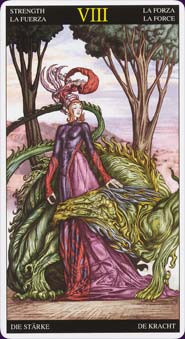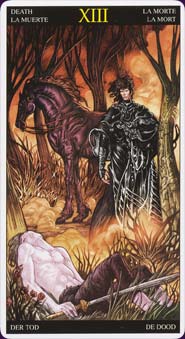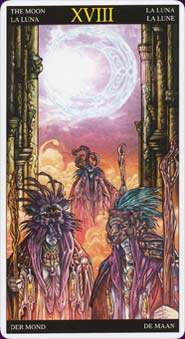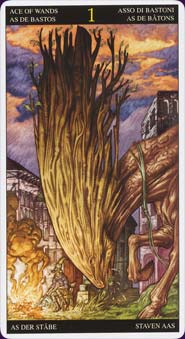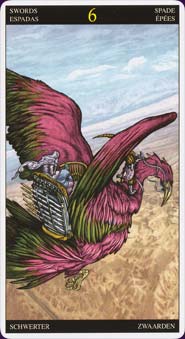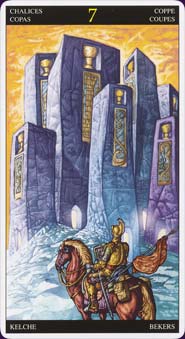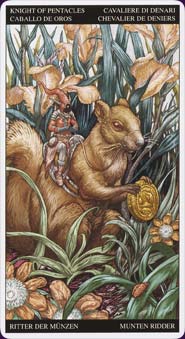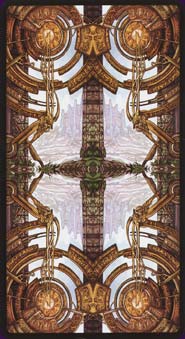Universal Fantasy Tarot Deck Review
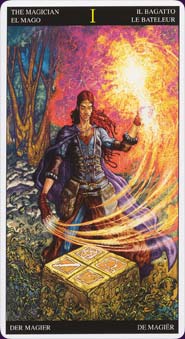
The Universal Fantasy Tarot is set in the fictional world of fantasy literature. A world of magic, inhabited by dragons, witches, winged horses, heros, gods and demons, it is here illustrated on 78 fantastical cards.
Deck Type: Tarot Deck Cards: 78
Creators: Paolo Martinello
Publisher: Lo Scarabeo 2006
Retailers
See Price at Amazon.comSee Price at Amazon.co.uk
See Price at Amazon.ca
Universal Fantasy Tarot Review by Kate Hill
"Ancient symbols are reinterpreted, using the imaginary world of Fantasy literature. Every icon refers to a universe where elements of the medieval world merge with others that belong to myth and fantasy, taking on new meanings, but maintaining ancient content and symbolism." – from the booklet
The Universal Fantasy Tarot is a deck based on the fantasy novel genre, the imagined literary world fathered by English author William Morris and later popularised by Tolkien, Moorcock and others. This fantasy world is a blend of magic and the Middle Ages, and is inhabited by dragons, witches, unicorns, demons, elves, and heroes.
The deck pictures these and even more mythical creatures: giant mice, centaurs, satyrs, giant lammergeiers, naiads and water sprites in the Six of Pentacles, enormous flying snails in the Six of Chalices. There are fantastical monsters grown of wood and trees: The Ace of Wands has a cloven-hoofed, muscled animal with a giant head like a cluster of sprouting branches, that makes the shape of the club that appears in more standard depictions of this card.
In places, the artistic style of Paolo Martinello reminds me of the Revelations Tarot with its flowing, almost stained glass look, and because it takes a few moments to adjust the eye to the busy-ness of the images. There is also a similarity to the Gilded Tarot in the mechanistic, complicated clock-work touches used on the World and the Ace of Pentacles. Some cards that are closer to the robotic, science-fiction side of the fantasy genre - the Five of Swords is one, with its giant wearing rigid armour that mimics or grows from the town below.
I found a few cards to be confusing in their imagery (the Three of Pentacles in particular) but there were also some cards I very much liked. The Ace of Swords, with its image of a huge, airy hall with arches along each side, and a column in the foreground on which the sword is placed; green leaves twine around both. It has a spacious feeling; very airy. The Two of Pentacles, which depicts a lean, athletic person holding two long poles, with equally long flags attached: she is in constant motion, twirling the poles so that flags are full and intertwined around her. There are also a small number of cards with some female nudity, as in the Three of Chalices and the World.
Chalices, Wands, Swords and Pentacles are the suits in this deck, with Knave, Knight, Queen and King for the court cards. In most respects it sticks to the Rider-Waite basis and Strength and Justice are numbered VIII and XI respectively as well. The faces of the cards have an outer white border, then inner black sections at the top and bottom that hold the titles in six languages. (I liked this placement; all those titles are more unobtrusive than usual.) The backs of the cards have a reversible design of mechanical pieces overlaid over a distant landscape.
The companion booklet, the usual multi-language leaflet from Lo Scarabeo, has meanings that are generally Rider-Waite based. They come across as short and somewhat pompous - I probably wouldn't use it again with the cards, and would rely instead on the images themselves. For example:
1 - The Magician. Knowledge often requires sacrifice, but if we act with determination we can obtain our heart's desire.
Ace of Wands. There are times when we must let ourselves be guided by more intuition than by reason.
The divining method for the Universal Fantasy deck is called 'The Castle with 15 Rooms'. It's not a typical spread where you turn over all the cards, but has a row of six cards that are turned face up, and nine other cards that are turned over in response to a question. The suits are then matched between the turned card and the face-up card to generate the interpretation.
For all the possibilities offered by the fantasy universe, I found the Universal Fantasy Tarot's overall feeling to be rather melancholy. The colours used are predominantly cool blues, greys and greens instead of warmer yellows or reds, and the people in the deck are serious and rarely smiling, even in usually positive cards like the Sun or the Two of Chalices. Still, it's a usable and readable Tarot for those who like the imaginary imagery of the Fantasy genre.
Universal Fantasy Tarot Review by Gavin Pugh
‘Every icon refers to a universe where elements of the medieval world merge with others that belongs to myth and fantasy, taking on new meanings, but maintaining ancient content and symbolism.’ Universal Fantasy Tarot LWB
I have mixed feelings about this deck. On the plus side I love the artwork and the readings are interesting but on the downside some of the meanings in the little white book (LWB) are hard to link to either the images or more traditional (in terms of Waite inspired) meanings.
The art is certainly fantastical. There are kings riding squirrels, giants with buildings for armour, and spirit ladies, to name but a few of the odd happenings that take place in the mind of Paolo Martinello. He certainly has an active and fanciful imagination as well as a lot of skill. This deck is definitely a looker. Each card contains a lot of detail and some would be interesting to see in large format prints.
But for all its looks I find this deck difficult. For example the six of Chalices(cups) shows a man and woman sitting on the back of what can only be described as a giant snail, though that isn’t entirely accurate. The man is using chalices like a net to fish with. The LWB says, ‘Fate has unknown and surprising ways of revealing itself, sometimes linking distant times and feelings’. Comparing this with image I find it hard to make the correlation. I suppose the man could be dredging up the past and the subconscious.
This makes the deck a challenge, though not an unpleasant or frustrating one. The images just take some thought and interpretation. Another example is the 4 of Pentacles, where a woman is dancing in what could be a great hall with musicians behind her. The book says, ‘True power does not come from material possessions, but from values locked in our hearts.’ An interesting take on the Waite card but again it’s not obvious in the image of the woman. The value here is, perhaps, the stimulation of a woman dancing and the power she hold over those watching.
Several cards contain elements of nudity mostly bare chests both male and female though nothing is explicit or gratuitous. The Court cards are varied in their character for example the King of Wands has floating islands visible from his window and Queen of Wands looks like she is wrapped in flowing water.
As with all Lo Scarabeo decks the cards titles are in multiple languages. Due to the style of the black border I didn’t find this in anyway distracting. The LWB contains translations in English, Italian, Spanish, French and Dutch. Strength is 8 and Justice 11. And wands are fire with swords being air. The Courts are Knave, Knight, Queen, King.
This is not an easy deck to pick and rely on the cards alone, but in readings the cards that do come are right ones. I’ve enjoyed being challenged by them, which I’d put down to the artwork. It is Waite-esque so there is a point of reference for the meanings. So anyone with knowledge of that deck or its derivatives should cope fine. I think that what may be lacking is the understanding of an underlying structure, if indeed there is one, as the only reference to a structure is, ‘In these tarot card created by Martinello, the ancient symbols are reinterpreted, using the imaginary world of Fantasy literature.’
For all its strangeness the Universal Fantasy Tarot is a readable and enjoyable deck. I wouldn’t recommend this for beginners due to the confusing little white book. But for those with more experience, who like fantasy artwork and want a unique filter to pass through their meanings, then this is the deck for you.
Universal Fantasy Tarot Review by Lynda Cowles
Reading with the Universal Fantasy is like entering another world – a world populated entirely by the imagination. The aim was to create a deck based on the much-loved fantasy genre, complete with magical elements such as wizards, dragons and giants. Yet the Universal Fantasy goes further, pushing the boundaries of what is commonly considered fantasy, presenting us with a world beyond the walls of the ubiquitous Lord-of-the-Rings-style lands. The resulting deck is colourful, inventive and distinctive, with not an elf in sight.
It’s been a long time since I was so blown away by the art of a deck. I am not typically a fan of fantasy artwork, but it’s impossible not to marvel at Paolo Martinello’s visionary illustrations. Whether it’s the half-bird, half-arachnid creature of the 8 of Swords, the golden tree-nymph of the 4 of Cups, or terrifying alien-like beauty of The Empress, there is something in every card to make your jaw-drop. The rich, flowing fabrics worn by most characters are especially beautiful, to the extent that the few cards featuring nudity – for example, the Star – are disappointing in comparison.
But obviously, there needs to be more to a tarot deck than pure aesthetics. So how does the Universal Fantasy measure up, divination-wise? In general, the deck seems to be loosely modelled on traditional meanings, though some cards are more faithful than others. For instance, it is very difficult to relate the 8 of Wands image, which portrays a bird sitting on an elaborate nest containing unhatched eggs, to the common meanings of swift action and movement.
On the other hand, there are many images which need no explanation and which speak directly to the instincts. One such card is the 9 of Swords. In this, a young woman cowers in a corner of a tiny room as a large, many-sworded shadow looms over her. As the LWB so succinctly puts it: “Like shadows, the demons inside us always seem larger and more threatening than they really are.”
Symbolic details can be found in many of the fantastic images, proving the deck is more than just a pretty face. The Hierophant sits on a high throne, from which hang several inscribed metal tokens. These are his keys, and the writing on them marks them as keys of wisdom and understanding. Behind the throne is a curious image of a naked woman in a glass case. She appears to be in a trance and reminded me of the oracles of Ancient Greece, but only the Hierophant is able to hear and interpret her messages for the masses.
The accompanying LWB is short, but good. A brief interpretation of one or two sentences is given for each card and - like the enigmatic wisdom hidden in fortune cookies – these statements can be as significant as you allow them to be. In that way, they provide useful sparks for thoughts about a card’s message and in many cases are surprisingly enlightening. This can be illustrated with the description for the 4 of Wands, which says: “A job is well done when all we have done is what needed to be done and no more.” The card shows a house perched high up on rickety stilts. It’s a ramshackle, topsy-turvy-looking house but a house nonetheless. To me, this card is symbolic of the concept of “enough” and of recognizing when to step back and appreciate what we’ve achieved. How often do we continue to strive for perfection long after our efforts can make any real difference, because we don’t feel what we’ve done is good enough?
In this way, the cards’ meanings are not set in stone but rather hidden beneath layers of colourful silk, to be unwrapped by each reader. Ultimately, the Universal Fantasy is a wonderful gift – passed from the imagination of its creator to the imagination of its readers, and it’s down to us to discover and explore the delights it holds.
Complete Details of Universal Fantasy Tarot
Creators: Paolo MartinelloPublisher: Lo Scarabeo 2006
Deck Type: Tarot Deck
Cards: 78
Major Arcana: 22
Minor Arcana: 56
Deck Tradition: Rider-Waite-Smith
Minor Arcana Style: Unique Scenes Without Suit Symbols
Suits: Chalices, Swords, Wands, Pentacles
Court Cards: Knave, Knight, Queen, King
The Fool is 0
Strength is 8
Justice is 11
Card Size: 2.60 x 4.72 in. = 6.60cm x 12.00cm
Card Language: Spanish, Italian, German, French, English, Dutch
Card Back: Reversible
Companion Material: 64-page companion booklet in six languages.
Rating: 14/20 or
Similar Decks to Universal Fantasy Tarot
Theme: FantasyCreator: Epic Tarot, Mona Lisa Tarot by Paolo Martinello
< Previous Deck · Back to Top · Next Deck >
Home > Tarot Reviews > Universal Fantasy Tarot Review

